
Northern Inuit Dog

"Echo" - Frequently placed Best in Show
|

"Sansorrella Pagan Promise"
|
There are many admirers of the Timber Wolf but it is not practical or fair to keep these wild animals as domestic pets. The aim of the founders of this breed was to satisfy this love of the wolf, by creating a breed that resembled the wolf in appearance while having the loyal and affectionate nature required of a family companion.
A
Court case was fought in 1995, which proved (albeit on a technicality)
that the 'Northern Inuit dog' is
not a wolfdog or wolf hybrid. The 'Northern Inuit dog' is merely a wolf
look-a-like with wolfish qualities.
Brief History (fuller history is given in "The Wolf Lookalike Handbook") The 'Northern Inuit dog' is a relatively new, manmade type of dog. The name 'Northern Inuit dog' is a misnomer since I am led to believe the breed has nothing whatsoever to do with genuine Inuit dogs and is therefore misleading. It is also politically incorrect and insulting to the Inuit people, who have my full support and understanding in their frequent complaints regarding the name. It is my personal opinion that the name should be changed to reflect what this dog truly is and its UK origins. A small group of breeders, including myself, will be changing the name of our dogs, as well as improving the lines we breed, and from 2009 our dogs will be known as Anglo Wulfdogs. The 'Northern Inuit breed' stems from the late 1980’s, when various northern breeds of dog, some imported, were selected for type and size (including Husky and Malamute crosses) and another breed for trainability (the German Shepherd). These were carefully bred over several generations by Edwina Harrison and a few others to create the 'Northern Inuit dog' we know today. In the early years a handful of other dogs were included to improve the 'breed' and set certain characteristics. It is rumoured that some of these dogs were crossed with wolves. However, an investigation by DEFRA was unable to prove this and they believed it was highly unlikely and most probably a claim made in order to obtain a higher price for pups. If our dogs did originate from wolf hybrids then it was many generations in the past and the wolf content would now be miniscule. For many generations now the 'Northern Inuit dog' has been bred pure, Northern Inuit to Northern Inuit, and a loose type has been established but there are still variations on that type.
The reader should see the
Health
Problems page, along
with the articles on the
Genetics
page and
Breeding for Genetic Health page,
regarding concerns over the consequences of repeated inbreeding.
Breeders were mislead in the belief that the gene pool was sufficiently
large to support the breed and indeed on 3 or 4 generation pedigrees it does
appear to be the case. However, if we take pedigrees back 7
- 10 generations there is a totally different picture and I can't stress
strongly enough that the gene pool needs to be expanded if the 'breed' is
to have a viable and healthy future.
Sansorrella,
together with a handful of other responsible breeders, took advice from
renowned genetics experts and instigated a new breeding programme in 2009 that should address
these issues (see Anglo Wulfdogs
for more information).
|

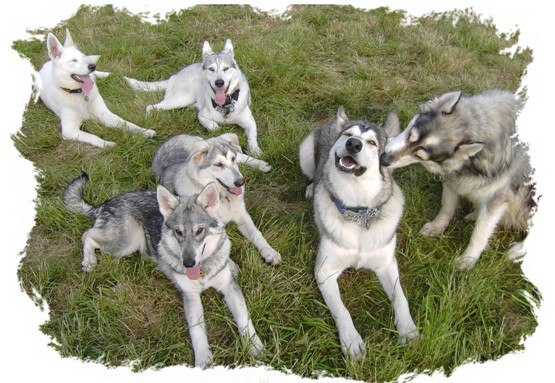
Some of the Sansorrella Pack
|
"Cloud" |
Breed ProfileThe 'Northern Inuit dogs' we have today withhold some of the characteristics and traits of Inuit type dogs but without the intense working drive that would prevent family life. They have a calmer nature more befitting of the family dog. Although originally this type of dog would have to battle against the elements for basic survival they have fitted in well with our modern day lifestyle as a loyal pet, capable of competing successfully in obedience, agility, fly ball, canix and the popular sport of pulling rigs. Where the 'Northern Inuit dog' has not proved a success is as a guard dog, due to their friendly manner and willingness to greet any visitor as a long lost friend in an extremely boisterous and exuberant manner! The 'Northern Inuit dog' is a very affectionate and versatile dog, with an incredible sense of smell and willingness to please. The future of the 'Northern Inuit dog' looks bright and could provide future services such as Search and Rescue dogs, Hearing Dogs for the deaf, P.A.T dogs or simply as the pride and joy of families as their loyal and loving pet. A handful of dogs are already being trained as a Search and Rescue dogs and some have qualified as P.A.T. dogs. Several Northern Inuit dogs have passed the KC Good Citizen Award scheme, achieving Bronze, Silver and Gold standard for their proud owners. |
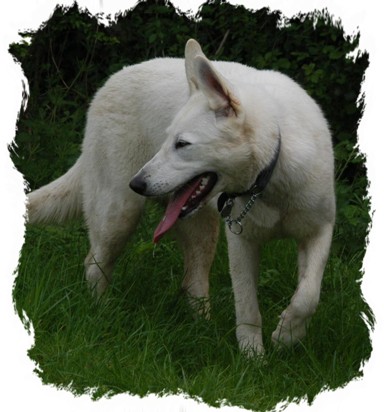 Sansorrella Wanagi |
|
If introduced at a young age 'Northern Inuit dogs'
mix well with other pets, but it must always be remembered that they
naturally have a very high prey drive and should never be left alone
with other domestic pets or livestock. Because of their friendly
personalities they love the companionship of other dogs and very rarely
argue, usually submitting when challenged.
They make great family members and like to
be included in everything the family does.
They love children and are happy to play
games for hours or cuddle up on the sofa for a kip.
Those that are privileged to own a 'Northern
Inuit dog', or more, know how loving and caring these dogs truly are.
However, they are not
a dog that can be left alone while you are at work, this can lead to a
very distressed dog and destructive behaviour.
They have a very strong pack instinct and it
cannot be over emphasised that they need
constant company, human or canine - but any
canine companion should be large enough to take the rough and tumble of
Northern Inuit play. |
.jpg) Sansorrella Simply Adorable |
The 'Northern Inuit dog' is a faithful companion and
bonds very closely with their family.
You never forget that smile; they have a
wonderfully expressive face and really do ‘smile’.
They require a medium level of exercise as
they are not over active dogs, but they are boisterous in play!
'Northern Inuit' dogs are larger than a Siberian
husky, with dense double coats ranging in colour from white through to
black and reds, with grey being the most common.
They can have a ‘mask’ but colour change
should be subtle.
They moult twice a year; the heaviest being
the spring moult but good brushing keeps this under control.
Some 'Northern Inuit' dogs do not tolerate
cereal based complete dogs foods very well and as a breed they do best
on BARF diets.
'Northern Inuit dogs' are very independent and strong
willed dogs and are not really suited to a novice dog owner.
They are trainable (but it helps if you have
an abundance of patience and a good sense of humour) and they should be
well socialised from a very early age.
With confident handling they can be reliably
obedience trained and safely let off lead. |
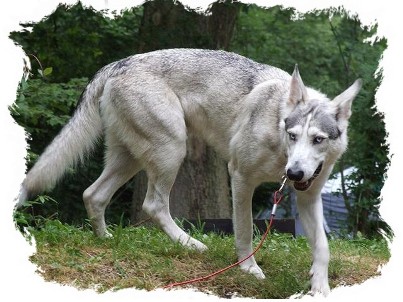 Sansorrella Blue Moon |

|
|
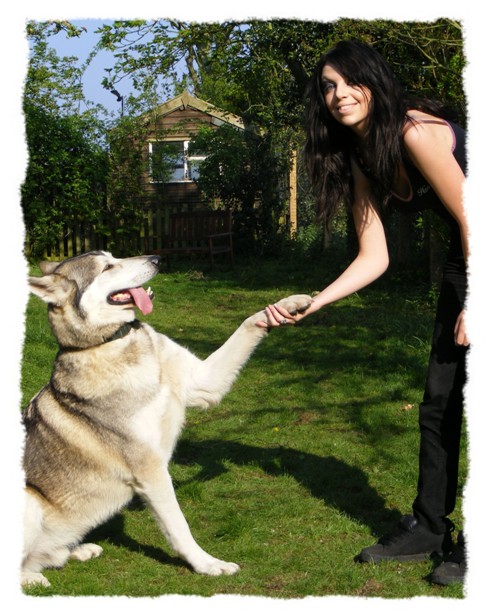 Sansorrella Spirit of the Sky with Aimee |
|
Some of the Sansorrella pack playing in the snow |
P
|
Some of the Sansorrella pack playing |
| You may have noticed that I refer to the Northern Inuit dog as a 'breed', in inverted commas. This is because I do not believe they will ever be recognised by the Kennel Club as a breed in their own right, due to the lack of honest, accurate and provable records from the foundation dogs to the present day. I therefore regard them as a 'wolf lookalike' type of dog. |
"Look into the eyes of a wolf and see your soul"


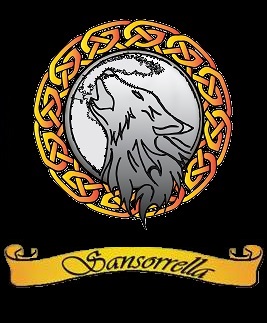
![]() Sansorrella 2010 All rights reserved
Sansorrella 2010 All rights reserved